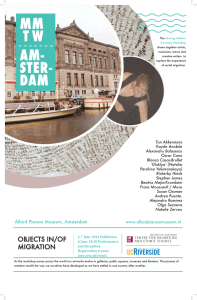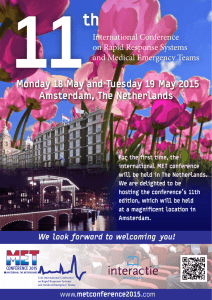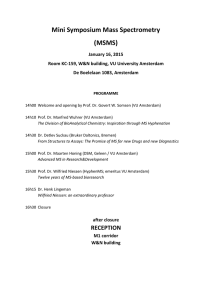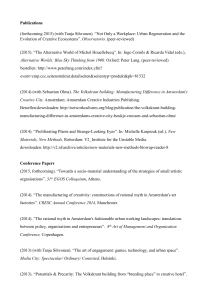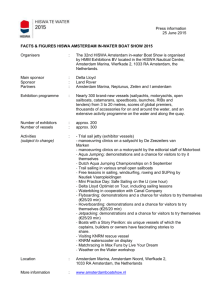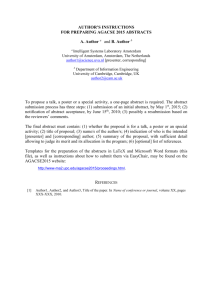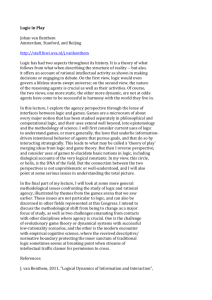General idea - Economic History Society
advertisement
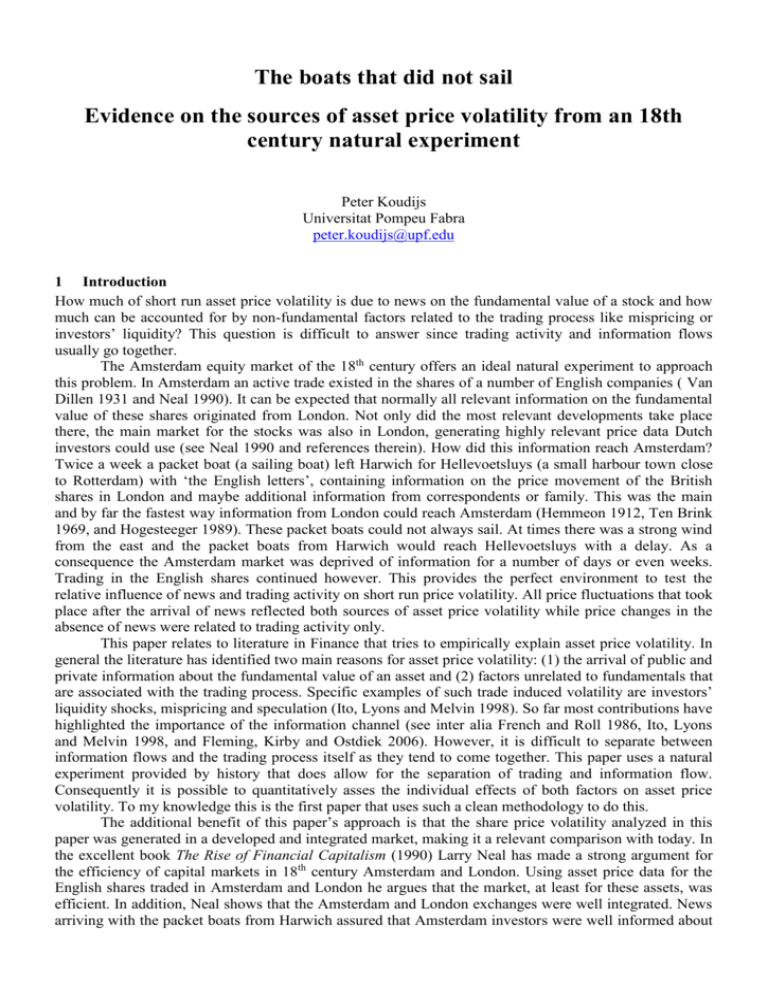
The boats that did not sail Evidence on the sources of asset price volatility from an 18th century natural experiment Peter Koudijs Universitat Pompeu Fabra peter.koudijs@upf.edu 1 Introduction How much of short run asset price volatility is due to news on the fundamental value of a stock and how much can be accounted for by non-fundamental factors related to the trading process like mispricing or investors’ liquidity? This question is difficult to answer since trading activity and information flows usually go together. The Amsterdam equity market of the 18th century offers an ideal natural experiment to approach this problem. In Amsterdam an active trade existed in the shares of a number of English companies ( Van Dillen 1931 and Neal 1990). It can be expected that normally all relevant information on the fundamental value of these shares originated from London. Not only did the most relevant developments take place there, the main market for the stocks was also in London, generating highly relevant price data Dutch investors could use (see Neal 1990 and references therein). How did this information reach Amsterdam? Twice a week a packet boat (a sailing boat) left Harwich for Hellevoetsluys (a small harbour town close to Rotterdam) with ‘the English letters’, containing information on the price movement of the British shares in London and maybe additional information from correspondents or family. This was the main and by far the fastest way information from London could reach Amsterdam (Hemmeon 1912, Ten Brink 1969, and Hogesteeger 1989). These packet boats could not always sail. At times there was a strong wind from the east and the packet boats from Harwich would reach Hellevoetsluys with a delay. As a consequence the Amsterdam market was deprived of information for a number of days or even weeks. Trading in the English shares continued however. This provides the perfect environment to test the relative influence of news and trading activity on short run price volatility. All price fluctuations that took place after the arrival of news reflected both sources of asset price volatility while price changes in the absence of news were related to trading activity only. This paper relates to literature in Finance that tries to empirically explain asset price volatility. In general the literature has identified two main reasons for asset price volatility: (1) the arrival of public and private information about the fundamental value of an asset and (2) factors unrelated to fundamentals that are associated with the trading process. Specific examples of such trade induced volatility are investors’ liquidity shocks, mispricing and speculation (Ito, Lyons and Melvin 1998). So far most contributions have highlighted the importance of the information channel (see inter alia French and Roll 1986, Ito, Lyons and Melvin 1998, and Fleming, Kirby and Ostdiek 2006). However, it is difficult to separate between information flows and the trading process itself as they tend to come together. This paper uses a natural experiment provided by history that does allow for the separation of trading and information flow. Consequently it is possible to quantitatively asses the individual effects of both factors on asset price volatility. To my knowledge this is the first paper that uses such a clean methodology to do this. The additional benefit of this paper’s approach is that the share price volatility analyzed in this paper was generated in a developed and integrated market, making it a relevant comparison with today. In the excellent book The Rise of Financial Capitalism (1990) Larry Neal has made a strong argument for the efficiency of capital markets in 18th century Amsterdam and London. Using asset price data for the English shares traded in Amsterdam and London he argues that the market, at least for these assets, was efficient. In addition, Neal shows that the Amsterdam and London exchanges were well integrated. News arriving with the packet boats from Harwich assured that Amsterdam investors were well informed about developments in London. Differences in share prices between London and Amsterdam were small and generally short lived. In general it was only a matter of days before the asset prices in Amsterdam would reflect recent developments in England. This paper takes Neal’s findings as a starting point and uses the variation in the arrival of news in Amsterdam to tease out the different effects of fundamental information and trading induced factors on short run asset price volatility. I find that the short term volatility of the English shares in Amsterdam can for a large part (around two thirds) be attributed to factors unrelated to the fundamental value of these shares. The rest of the paper is organized as follows. Section 2 discusses the methodology of this paper in more detail. Section 3 presents the estimates of asset price volatility in periods with and without news. Section 4 provides evidence that news only travelled to Amsterdam by packet boat, implying that the identification of periods with and without news is correct. Section 5 concludes. 2 Packet boats in the 18th century: a natural experiment As mentioned in the introduction, a number of English assets was traded on the Amsterdam exchange during the 18th century: the East India Company (EIC), the Bank of England (BOE) and the South Sea Company (SSC). Data on the prices of these shares are available from the Amsterdamsche Courant, which reports prices for three dates a week (so with intervals of two or three days). The dates of arrival of news in Amsterdam are reconstructed using a number of sources, most importantly the Rotterdamsche Courant which reports the arrival of boats. Based on this I determine which prices reflected news from England and which prices did not. Because of data limitations the period of the analysis is confined to the years from 1771 to 1777. Only in September 1771 did the Rotterdamsche Courant start to report the arrival of the packet boats. The end date of the sample is determined by a war between England and France that started in February 1778. This war could have generated information that reached Amsterdam before it reached London, making the experiment unsuitable. I therefore decided to omit all information after 1777 from the sample. Empirical tests (unreported) indicate that for the period between 1771 and 1777 news flowed in one direction only: from London to Amsterdam and not the other way around. Figure 1 shows how the packet boats sailed. The English letters were first taken from London to Harwich by coach. In Harwich they were brought aboard a packet boat that would sail to Hellevoetsluys. In Hellevoetsluys the letters were offloaded and brought to the final destination by coach. There was considerable variation in the time it took for the packet boats to reach Hellevoetsluys. On average it took packet boats three and a half days to reach Hellevoetsluys, but in reality it could take anything between one and twenty days. As a consequence English news reached Holland with varying intervals. Crucially, this variation allows me to compare the volatility of returns in periods with and without news. For the analysis to be completely clean, the sailing time of a boat should be unrelated to any other information influencing share prices, like political developments. In other words, for my results to be valid sailing time has to be exogenous. Fortunately this is the case as sailing times were completely determined by the direction of the wind. Table 2.1 illustrates this point. The table presents the average wind direction for the days after departure of a packet boat up to the day that it arrived. Every sailing time corresponds with a row in the table. For brevity I only report the sailing times up to 8 days, as sailing times longer than 8 days occurred rarely. The wind direction is reported in degrees, with the North being 360 or 0 degrees, and comes from the observatory of Zwanenburg, a village close to Amsterdam (KNMI). Figure 2.1 Route of the packet boats Amsterdam Harwich Hellevoetsluys London Source: www.atlasofmutualheritage.nl Table 2.1 Sailing time and wind direction Sailing Wind direction (degrees) time obs. t+1 t+2 t+3 t+4 t+5 (days) 1 4 237 2 148 244 244 3 315 246 246 246 4 140 332 54 99 184 5 47 112 85 91 98 152 6 15 101 77 80 79 67 7 8 106 101 95 96 112 8 7 166 55 38 83 71 Source: Rotterdamsche Courant and KNMI t+6 104 117 50 t+7 187 148 t+8 124 Figure 2.1 shows that Hellevoetsluys is situated east-to-south (approximately 100 degrees) relative to Harwich. This implies that if the wind is blowing from the same direction, the packet boats will have serious difficulty in reaching Hellevoetluys. If, on the other hand, the wind blows from the opposite direction (west-to-north, or 280 degrees) the boats will reach Hellevoetsluys quickly. For any intermediate value the boats are probably able to advance, but their speed will depend on the exact wind direction. Table 2.1 shows that this is indeed the case and that the direction of the wind can almost perfectly explain sailing times. Day t+1 is the first day at sea. For short sailing times the wind direction is close to the optimal 280 degrees for all days. For longer sailing times this is not the case. Take a sailing time of 4 days for example. The average wind direction on day t+1 is close to North (not ideal, but not dramatic either), but for t+2 and t+3 the wind blows from the East, preventing the boats from advancing. Only when the wind turns south are the boats able to approach Hellevoetsluys. 3 The sources of asset price volatility Based on reconstruction of the dates on which news arrived in Amsterdam I can determine when the share prices of the English Companies in Amsterdam contained new information and when they reflected the same information as the previous price. Based on this I construct returns and I separate the sample of returns in two groups, one with news and the other without. The return on asset i ( Rit ) can be attributed to two parts: Rit log Pit log Pit 1 f Fit Fit 1 , NFit NFit 1 f Fit , NFit (3-1) The first part, Fit , reflects the arrival of news from England and can be considered a change in the information investors had on the fundamental value of the stock in England. The second part, NFit , reflects the change in non-fundamental factors that are related to the trading process. Depending on whether or not news arrives at time t returns with or without news can be written as follows. RitNEW S f Fit , NFit (3-2) RitNONEW S f 0, NFit (3-3) and Assuming that the function f is separable in Fit and NFit and that these two variables are uncorrelated (both contemporaneously and over time), these expressions can be simplified to calculate the relative contributions of both factors to total asset price volatility: VFi V RitNEW S V RitNONEW S V RitNONEW S 1 V RitNEW S V RitNEW S (3-4) and V RitNONEW S VNFi V RitNEW S (3-5) with VFi the return variance that can be attributed to the arrival of news and VNFi the return variance that can be attributed to the trading process. The above exercise was performed on the return data (three observations a week) of the EIC, the BOE and the SSC between September 1771 and December 1777. Return distributions are non-normal, making the variance a poor summary statistic. I therefore use the average absolute deviation from the mean: 1 V Rit absRit R i (3-6) T T with R i the mean return of stock i . Table 3.1 presents these volatility measures for the three funds, broken down for returns with and without news. In addition, the table presents estimates of the relative contributions of information and trading activity to total volatility as defined in equations (3-4) and (3-5). Table 3.1 Estimates of return volatility VFi VNFi V RitNEW S V RitNONEW S N N EIC 0.0053 481 0.0032 331 0.39 0.61 BOE 0.0025 480 0.0020 329 0.21 0.79 SSC 0.0030 476 0.0020 329 0.31 0.69 Table presents volatility estimates of returns based on the average absolute deviation from the mean. Returns are calculated according to equation (3-1) and are in fractions. Source: Amsterdamsche Courant and Rotterdamsche Courant, September 1771 – December 1777 The table reveals that the relative contributions of information and non-fundamental factors to overall volatility differ for each stock. However for all three companies non-fundamental factors dominate information: the contribution of factors unrelated to information lies between 61 and 79 percent. Although the arrival of news has an important influence on returns, short run volatility is for the largest part driven by factors related to the trading process. 4 Possible alternatives to the packet boat The analysis of this paper hinges on the crucial assumption that the packet boat was the only way (or at least the fastest way) by which information could reach Amsterdam. Although the packet boat formed the only official mail service with England (Hemmeon 1912 and Ten Brink 1969, p. 24), it is possible that there were unofficial ways by which English news could reach Amsterdam. It can be tested empirically whether this was the case. Larry Neal has generously made his data on daily share prices in London available. Combining my data with his dataset it is possible to compare the price development of the British shares in Amsterdam and London. If the packet boats were indeed the only channel of information, returns in London and Amsterdam should have been strongly correlated after the arrival of news and this correlation should have broken down in the absence of news. Table 4-1 presents the results from regressing Amsterdam returns on London returns. The latter are lagged by the number of days it took for the English letters to reach Amsterdam. Regressions results are reported for each stock individually and refer to periods with and without news. From the table it becomes clear that returns in Amsterdam and London are significantly correlated when news is coming in. This correlation disappears when no packet boat arrives: relative to the situation in which news does arrive, both the coefficient and its statistical significance are considerably smaller. This is strong evidence that the packet boat was the only way by which English news could reach Amsterdam. Table 4.1 Co-movement returns Amsterdam-London Amsterdam return EIC BOE SSC news no news news no news news no news London return 0.3090 0.0650 0.2520 0.1090 0.2660 -0.0120 (0.0000)*** (0.2480) (0.0000) *** (0.1300) (0.0000) *** (0.7310) Constant 0.0000 0.0000 0.0000 0.0000 0.0000 0.0000 (0.3140) (0.1630) (0.3630) (0.6110) (0.8540) (0.8180) R2 0.16 0.01 0.13 0.02 0.12 0.00 Results from regressing Amsterdam on London returns for periods with and without news. London returns are lagged by the number of days it took for the English letters to arrive in Amsterdam. P-values based on robust standard errors reported in parentheses. *** significant at the 1% level Sources: Amsterdamsche Courant, Rotterdamsche Courant, September 1771 – December 1777 and Neal (1990) 5 Conclusions How much of short run asset price volatility is due to news on the fundamental value of a stock and how much can be accounted for by non-fundamental factors related to the trading process like mispricing or investors’ liquidity? In this paper I have used a natural experiment provided by the 18 th century Amsterdam equity markets to approach this question. In the 18th century a number of British stocks were traded on the Amsterdam exchange and all relevant price information from England reached Amsterdam through the use of mail boats. This paper identifies periods in which these boats could not sail because of the weather and analyzes what this lack of information implied for the volatility of the British stocks traded in Amsterdam. I show that asset price volatility during periods without news was around two thirds of the volatility that is observed during periods with news. This suggests an important role for nonfundamental factors in the day to day movement of asset prices. 6 References Secondary literature: Fleming, Jeff, Chris Kirby, and Barbara Ostdiek, `Information, Trading, and Volatility: Evidence from Weather-Sensitive Markets’ in: The Journal of Finance 61-6 (2006) French, Kenneth R. and Richard Roll, R ‘Stock return variances: The arrival of information and the reaction of traders’ in: Journal of Financial Economics 17 (1986) Hemmeon, J.C., The History of the British Post office, Cambridge: Harvard University Press (1912) Hogesteeger, G., Van lopende bode tot telematica, Groningen: PTT Nederland (1989) Ito, Takatoshi, Richard Lyons, and Michael Melvin, ‘Is There Private Information in the FX Market? The Tokyo Experiment’ in: The Journal of Finance 53-3 (1998) Neal, Larry, The Rise of Financial Capitalism: International Capital Markets in the Age of Reason, Cambridge: Cambridge UP (1990) Ten Brink, E.A.B.J., De geschiedenis van het postvervoer, Bussum: Fibula (1969) Van Dillen, J.G., ‘Effectenkoersen aan de Amsterdamsche Beurs 1723-1794’, Economisch Historisch Jaarboek 17 (1931) Primary sources: Amsterdamsche Courant, City Archive Amsterdam Koninklijk Nederlands Meteorologisch Instituut (KNMI) Rotterdamsche Courant, City Archive Rotterdam
